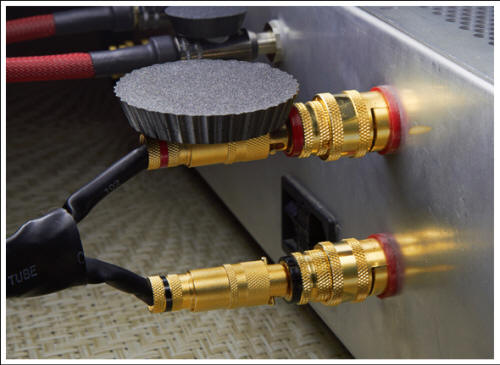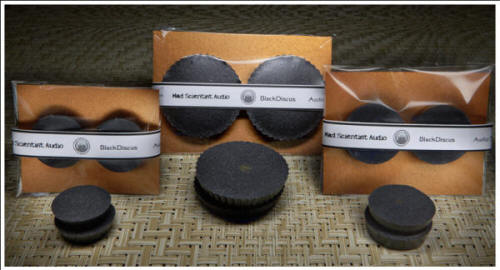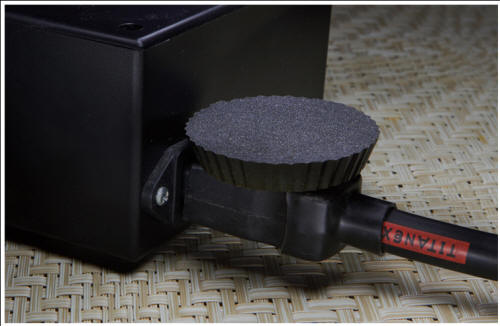|
|
You are reading the older HTML site
Positive Feedback ISSUE 72
mad scientist audio BlackDiscus - Life as an Audiophile as reviewed by Will Wright
About three years ago the left 60 inch full range ribbon in my speaker system stopped working. Close inspection showed that the foil trace on the kapton film was broken. Having had the speakers for a long time, my first assumption was that it had failed due to fatigue. As it happened I had a spare pair of ribbon drivers acquired from a friend who had purchased them for a project and never used them. I think I paid around $600 for the pair. I replaced the faulty ribbon (no small task) and everything sounded fine. Then, a few days later the new ribbon failed. Since I use electronic crossovers ahead of the amplification, the only culprit could be one of my Krell amps. The nearest Krell dealer at the time was Nuts About Hifi in Silverdale, Washington. After contacting them, I was told that they didn't do repair work, choosing instead to send units back East to Krell headquarters in Connecticut. Since the KSA 200S weighs 125 pounds without the shipping container, I was advised to use a freight company should I decide to take that option. Round trip freight would run about $500. Before ending our conversation, the salesman at Nuts About Hifi suggested I contact Magnolia Hifi and Video in Seattle. I was told that they had been a Krell dealer at one time, and might still have repair staff qualified to work on my amp. Sure enough, Magnolia still had a tech in their repair facility who was a certified Krell technician. I made arrangements with them to have the amp serviced. Subsequently, I was told that many of the capacitors in the amp were starting to fail due to age. The amp was about 20 years old. Although I am aware the aging process takes its toll on electrolytic caps, 20 years seemed a bit short for a "Super Amp" such as a Krell. I've known people with Sansui receivers that lasted 30 years before having capacitor problems. The tech speculated that Krell may have selected the caps based on sound quality without knowing the expected life span. Regardless of the reasons for failure, something had to be done and I approved replacement of the capacitors. I also sent in my other identical amp to have the process repeated. Total cost of repair for both amps was about $1000. That would have covered only the shipping costs if I'd had to send both amps back to Krell. Upon returning the amps to me, the Magnolia Tech told me that I was good for another 20 years. While the amps were in for service, I replaced the damaged ribbon driver with my final spare. Price inflation being what it is, I doubt that I could get a single ribbon today for what I had paid for the spare pair. A little research uncovered a company that would rebuild these ribbons for about $500 each. This had been a costly failure. Life As An Audiophile Part 2 Fast forward to about a year ago. Up until this point, I had encountered no further difficulties with the two Krell amps. Then one day the right channel sub driver burned out. Interestingly, when the two amps were returned to me, their positions had been swapped when I reinserted them into the system. Sure enough, the same amp and the same channel had now eaten another driver, this time a 15 inch dual voice coil woofer. Those caps might have been aging, as reported, but clearly something else was afoot. I pulled the amp from the system again and did some bench testing. In most cases, what takes out woofers is DC. The KSA200S amp is protected by a series of non-intrusive opto-coupled circuits said to constantly evaluate the amps operation to protect against DC, short circuit, oscillation, AC power anomalies, high ground resistance and out of phase ground. On the test bench, I could find no significant DC offset issue or any other anomalous behavior. What I had was an intermittent problem, the worst kind to troubleshoot. I contacted Magnolia Hifi and Video again but was told that, due to the age of the amps, Krell refused to provide parts or service information to the Magnolia tech I had use before. I was on my own. Several months went by while I searched through my alternatives. Since the subwoofers were a homemade design, I had added no fuses or protection circuitry, meaning that the woofer in each sub was directly connected to the amp output, leaving it at the mercy of any intermittent DC signal. Eventually, I decided to add DC blocking filters to the sub drivers. Based on the voice coil impedance, I designed a filter that would high pass at about 9Hz and added filters to both subs. At least this way, until the amps failure was no longer intermittent, my drivers were safe, or at least safer. By this time my system had been out of use for several months. After firing everything up again, my first listening sessions were surprising. Essentially, I had to go through several days of break in before things started to settle down and sound the way I expected. During that period everything sounded hard edged and aggressive. Mad Scientist Indeed It was at about this time that I acquired review samples of the Mad Scientist BlackDiscus system enhancing tweak. Mad Scientist Audio, based out of New Zealand and run by Bob Prangnell, is new to me. It appears that the company was formed to market the BlackDiscus product, since there are no other products in their line at present. So what is a BlackDiscus? According to the website, a BlackDiscus is made of an epoxy-based composite. This composite undergoes proprietary processing steps, the nature of which are not revealed or even hinted at. The claimed result manifests itself in several effects but, again, nothing is revealed about the nature of these effects except to say that they comprise both near field and far field influences on a treated system. If this were an effect based on a combination of materials, someone could theoretically reverse engineer the product by analyzing the materials. A proprietary process, however, is another thing altogether.
No, Bob Pragnell won't tell you how the BlackDiscus devices work, but he will tell you what the effect will, or should, sound like. His website also offers several suggestions for placement to achieve the desired results. The product comes in four configurations. There are three different sizes of round flat discs, the largest of which sports an exterior edge reminiscent of a Reese's Peanut Butter cup. The fourth device, called a BlackDiscus Black Stick is more finger shaped and is intended for use on cables. Setup For me, the simplest approach was to place a BlackDiscus near the IEC power receptacle on each piece of gear, held in place by Blu-Tack as provided with the disc. I didn't really do much experimentation with location after the initial positioning of the discs. Although Prangnell mentions the possible application of devices internally on power transformers, etc., all my listening is based on external use of the discs in their initial locations. Those more curious in this regard should consult the Mad Scientist website for further positioning suggestions. That's all there is to it. Just stick them on and see what happens.
Listening As mentioned above in the introduction, I'd been listening to my system a lot during and after the re-break in period required after several months of disuse. I played a variety discs, including old favorites with which I was intimately familiar to confirm that the system was fully re-stablized prior to inserting the BlackDiscus tweaks. The instructions suggest that the effect could take a while to establish itself and recommend leaving them in place for a while prior to critical listening. Bob Prangnell also suggests that, due to the far field effects, when making A/B comparisons, the devices be moved as far from the system as possible or be placed in a metal container. As anyone who has played with system tweaks will testify, in most cases, the results are subtle, particularly if you have no idea what to expect or how to listen for the difference. Listening to the first disc, my initial reaction was that nothing had really changed. I settled in for an evening of music and relaxation. My music collection, like most people's I'm sure, varies from good music poorly recorded to less engaging but excellently recorded and all points in between. Over a period of several hours and a variety of music, it became clear that the effect of digititus, that edgy digital sound especially noticeable in poorer quality efforts, was significantly reduced but with no loss of detail or clarity. That alone made the BlackDiscus a winner. But wait, there's more. I was listening to Fleetwood Mac Greatest Hits from 1988. This is an example of the good music but mediocre digital transfer typical of a lot of '80s CD releases. But instead of the expected flat, nonexistent sound stage, I was actually hearing depth, instrument placement and in some cases sound that actually projected an image out into the room. The improvement in listenability was altogether natural and most welcome. In fact, in no instance regardless of material did the BlackDiscus tweak ever detract from the sound. With some discs, the effect was less noticeable but was never anything but positive. Over the years I've tried a lot of tweaks. Some, like the Shakti Stones or Tice Clock, about which others were positive nothing in my system. Others ranged from very subtle (ERS paper, Audio Prism disc edge treatment, Bedini Clarifier) to a bit more profound (Bybee Quantum Purifiers). Power conditioning started out as a tweak and quickly established itself as a distinct product category. If I were comparing the BlackDiscus product to these other tweaks, I'd say that the effect was closer to the Bybee Purifiers but definitely not the same. Soundstaging and imaging were consistently improved. One other result is worth mentioning. With most systems I've listened to there is a particular volume level at which everything gels, transitioning at that point from background music to the palpable presence region. With the BlackDiscus treatment I felt that this hinge point was consistently reached at a slightly lower volume level. New Tricks Ok, if it worked well in my main system, what else could the BlackDiscus treatment do? Would I get similar results in my small surround system used primarily for video? This system is set up in a small bedroom and has 6.1 surround featuring the Oppo BDP-103 blu-ray player, an old but still good Outlaw Audio 1050 Reciever, a 39 inch Vizio display, and a Bybee power conditioner. The main speakers are from Newform Research, consisting of 30 inch ribbon drivers coupled to a sealed box with two 6.5 inch woofers. The sub is a modest 12 inch Outlaw Audio unit. I placed the BlackDiscus devices on the Oppo player, the Outlaw receiver and, just for kicks, the Vizio display. For test material, I pulled out two of the new Sono Luminus releases which combine a CD version and a Blu-ray version. The Blu-ray discs have 5.1 DTS HD MA 24/192, 7.1 DTS HD MA 24/96 and 2.0 LPCM 24/192. The two choices were the Ying Quartet's American Anthem featuring works by Samuel Barber, Howard Hanson and Randall Thompson, and Michael Lewin's Beau Soir piano works by Claude Debussy. If you haven't tried any of the new Blu-ray music discs you'll be pleasantly surprised. They are very clean high resolution audio only surround recordings. In my opinion, one of the main reasons for the demise of DVD-A was that it required a specialized player. If they had made DVD-A compatible (like the early DAD releases) with the large base of existing DVD players in homes, they might still be selling. It would appear that, when it came to Blu-ray, they learned their lesson. As it turned out, the effect of the BlackDiscus devices in this modest system were subtle at best. In particular, with video content, there was little difference until soundtrack or theme song music was present. Then there was a small but pleasant difference. And as to the display itself I was never really certain that anything changed except perhaps a bit more color saturation. Next, I took a BlackDiscus out to my car and tried to place it as near the stereo as possible. Again, the effect was subtle at best, although, in fairness, I was not able to place the disc in what I considered the ideal proximity to the CD player and I was only using one of the medium sized discs. Who's Zooming Who? Undeterred, I took my BlackDiscus samples to the home of an Audiophile friend with a nice setup featuring a Linkwitz designed dipole speaker system called the Orions. My friend's system produces a good sound but is handicapped by his living room which hinders ideal speaker placement and has some troublesome room acoustics. These acoustic issues add a bit of edge to the sound which he has been struggling to address without compromising livability. My thinking was that the BlackDiscus product might help him address these concerns. We put the devices in place and settled in for the evening with a bottle of wine. What I heard was a slight opening up of the soundstage and a bit of reduction in glare. My friend, however, although he admitted to hearing some improvement, wasn't sufficiently moved to pursue the purchase of the BlackDiscus product. Conclusions If I could assure the reader that he would achieve the results that I did in my main system, this recommendation would be a no brainer. I very much like what the BlackDiscus product does for me in that context. Obviously, the effect can be somewhat swamped by other issues. Success with this product is contingent upon your circumstances. If you have a highly resolving setup that isn't dominated by other problems, you will enjoy what the BlackDiscus product has to offer. The company does offer a small free sample and, as tweaks go, this one isn't particularly expensive. In fact, if this product interests you, buy it now before the price goes up and plan on one disc per piece of gear. As always, YMMV. Just as this was going to press Bob Prangnell contacted me regarding a variation he has been working on. He calls it a power conditioner and has promised me samples. In effect he uses several of the finger shaped Black Sticks in a configuration intended to go in line with the power cord. Look for pictures on the website. Bob claims that the effect is rather different from that achieved with the standard BlackDiscus products. I'll look forward to giving it a try. Will Wright
BlackDiscus Cupcake (large)
BlackDiscus Canopener (medium)
BlackDiscus Mini (small)
BlackDiscus Black Stick
|











